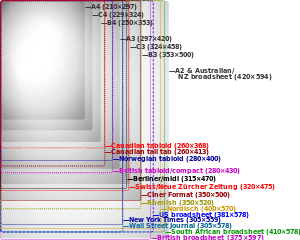Newspaper format

Newspaper formats vary substantially, with different formats more common in different countries. The size of a newspaper format refers to the size of the paper page; the printed area within that can vary substantially depending on the newspaper.
In some countries, particular formats have associations with particular types of newspaper; for example, in the United Kingdom, there is a distinction between "tabloid" and "broadsheet" as references to newspaper content quality, which originates with the more popular newspapers using the tabloid format; hence "tabloid journalism".
Trends
Manfred Werfel Research Director and Vice President of IFRA predicts a trend towards the Berliner format.
In a recent trend,[1] many newspapers have been undergoing what is known as "web cut down", in which the publication is redesigned to print using a narrower (and less expensive) roll of paper. In extreme examples, some broadsheet papers are nearly as narrow as traditional tabloids. An average roll of 26.4 lb (12.0 kg), 45 in (110 cm) diameter newsprint rolled out is 9.7 mi (15.6 km) long.
Sizes (aspect ratio)
- Broadsheet 749 mm × 597 mm (29.5 in × 23.5 in) (1.255)
- Nordisch 570 mm × 400 mm (22 in × 16 in) (1.425)
- Rhenish around 350 mm × 520 mm (14 in × 20 in) (1.486)
- Swiss (Neue Zürcher Zeitung) 475 mm × 320 mm (18.7 in × 12.6 in) (1.484)
- Berliner 470 mm × 315 mm (18.5 in × 12.4 in) (1.492)
- The Guardian's printed area is 443 mm × 287 mm (17.4 in × 11.3 in).[2]
- Tabloid 430 mm × 280 mm (17 in × 11 in) (1.536)
Comparison with ISO 216 (1.414)
- A2 594 mm × 420 mm (23.4 in × 16.5 in)
- B3 500 mm × 353 mm (19.7 in × 13.9 in)
- C3 458 mm × 324 mm (18.0 in × 12.8 in)
- A3 420 mm × 297 mm (16.5 in × 11.7 in)
- A4 297 mm × 210 mm (11.7 in × 8.3 in)
References
- ↑ "Press web". Naa.org. Archived from the original on July 4, 2008. Retrieved 2010-12-12.
- ↑ Richard Hollis. "How we got the measure of a Berliner". The Guardian.